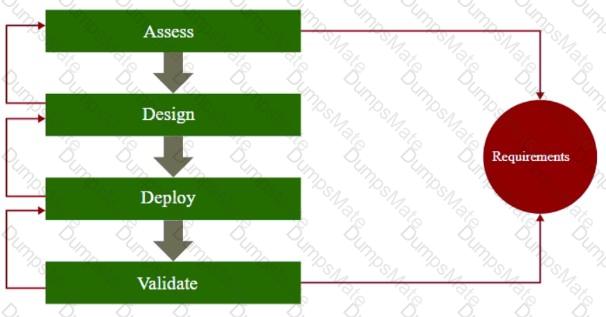Based on VMware vSphere 8.x Advanced documentation and the customer requirements, the architect is designing a greenfield vSphere-based solution for a highly transactional web application hosted across multiple workloads in a vSphere cluster. The workloads must be distributed evenly across hosts to maximize performance and availability, and the solution will use vSphere Distributed Switches (vDS) for virtual networking. The architect must select a network load balancing method for the physical design that aligns with these requirements.
Requirements Analysis:
Highly transactional web application: The application requires high network performance and low latency, as transactional workloads are sensitive to network bottlenecks.
Workloads spread across multiple workloads in a vSphere cluster: The application runs on multiple VMs, implying a need for balanced resource utilization across hosts.
Workloads distributed evenly across hosts: This suggests the use of vSphere features like Distributed Resource Scheduler (DRS) for compute load balancing and a network load balancing method to ensure even distribution of network traffic across NICs.
Maximize performance and availability: The network design must avoid bottlenecks, ensure redundancy, and dynamically adapt to traffic demands to maintain application performance and uptime.
vSphere Distributed Switches: vDS provides advanced networking features like Network I/O Control (NIOC), Link Aggregation Control Protocol (LACP), and dynamic load balancing, which are critical for meeting performance and availability goals.
Evaluation of Network Load Balancing Methods:
The load balancing method determines how traffic from VMs is distributed across the physical NICs (uplinks) in a vDS. The options are:
A. Route Based on IP Hash:
Description: Distributes traffic based on a hash of the source and destination IP addresses, requiring Link Aggregation Control Protocol (LACP) or EtherChannel configuration on the physical switch.
Why incorrect: While IP Hash can distribute traffic across NICs, it requires complex switch configuration and is less effective for dynamic load balancing in a highly transactional environment. It does not adapt to real-time NIC load, which could lead to uneven traffic distribution and potential bottlenecks, failing to maximize performance. It also increases complexity without clear benefits for this use case.
B. Route Based on Physical NIC Load:
Description: Also known as Load-Based Teaming (LBT), this method dynamically balances traffic across uplinks based on the actual load of each physical NIC, reassigning VM traffic if a NIC becomes congested (e.g., exceeds 75% utilization over a 30-second window).
Why correct: LBT is ideal for a highly transactional web application, as it ensures even distribution of network traffic across NICs, maximizing performance by preventing any single NIC from becoming a bottleneck. It supports availability by leveraging multiple NICs for redundancy and dynamically adapting to traffic patterns, aligning with the requirement to distribute workloads evenly. LBT works seamlessly with vDS and does not require complex switch configurations, making it suitable for a greenfield design. Combined with features like NIOC, it ensures optimal network resource utilization for the application.
VMware vSphere 8 networking documentation recommends Route Based on Physical NIC Load for dynamic load balancing in performance-sensitive environments.
C. Route Based on Originating Virtual Port:
Description: Assigns each VM’s traffic to a physical NIC based on the VM’s virtual port ID on the vDS, distributing traffic statically across uplinks.
Why incorrect: This method is simple and requires no switch configuration, but it does not account for actual NIC load, potentially leading to uneven traffic distribution if some VMs (e.g., transactional workloads) generate more traffic than others. It fails to maximize performance for a highly transactional application, as it cannot dynamically adapt to traffic spikes or ensure even NIC utilization.
D. Route Based on Source MAC Hash:
Description: Distributes traffic based on a hash of the VM’s source MAC address, statically assigning traffic to uplinks.
Why incorrect: Similar to Originating Virtual Port, this method is static and does not consider real-time NIC load, risking uneven traffic distribution and potential bottlenecks. It is less effective for a highly transactional application where dynamic load balancing is needed to ensure performance and availability.
Why B is the Best Choice:
Performance optimization: Route Based on Physical NIC Load dynamically balances traffic based on NIC utilization, ensuring no single NIC is overwhelmed, which is critical for a highly transactional web application with variable traffic patterns.
Even distribution: By monitoring and redistributing traffic, LBT aligns with the requirement to distribute workloads evenly across hosts, complementing DRS for compute resources with balanced network utilization.
Availability: LBT leverages multiple NICs for redundancy, ensuring traffic failover if a NIC fails, supporting the high availability needs of the application.
vDS compatibility: LBT is fully supported on vDS and integrates with features like NIOC to prioritize application traffic, enhancing performance and resilience.
Simplicity: Unlike IP Hash, LBT requires no complex switch configuration, making it ideal for a greenfield design.
Example Configuration:
vDS Setup: Configure a vDS with multiple uplink port groups for management, vMotion, and workload traffic (web application VMs).
Load Balancing: Set Route Based on Physical NIC Load for the workload port group to dynamically balance the application’s transactional traffic across available NICs (e.g., 2–4 x 10 GbE NICs per host).
NIOC: Use Network I/O Control to prioritize web application traffic over other traffic types (e.g., vMotion) during contention.
Redundancy: Ensure at least two NICs per port group for failover, aligning with availability requirements.





